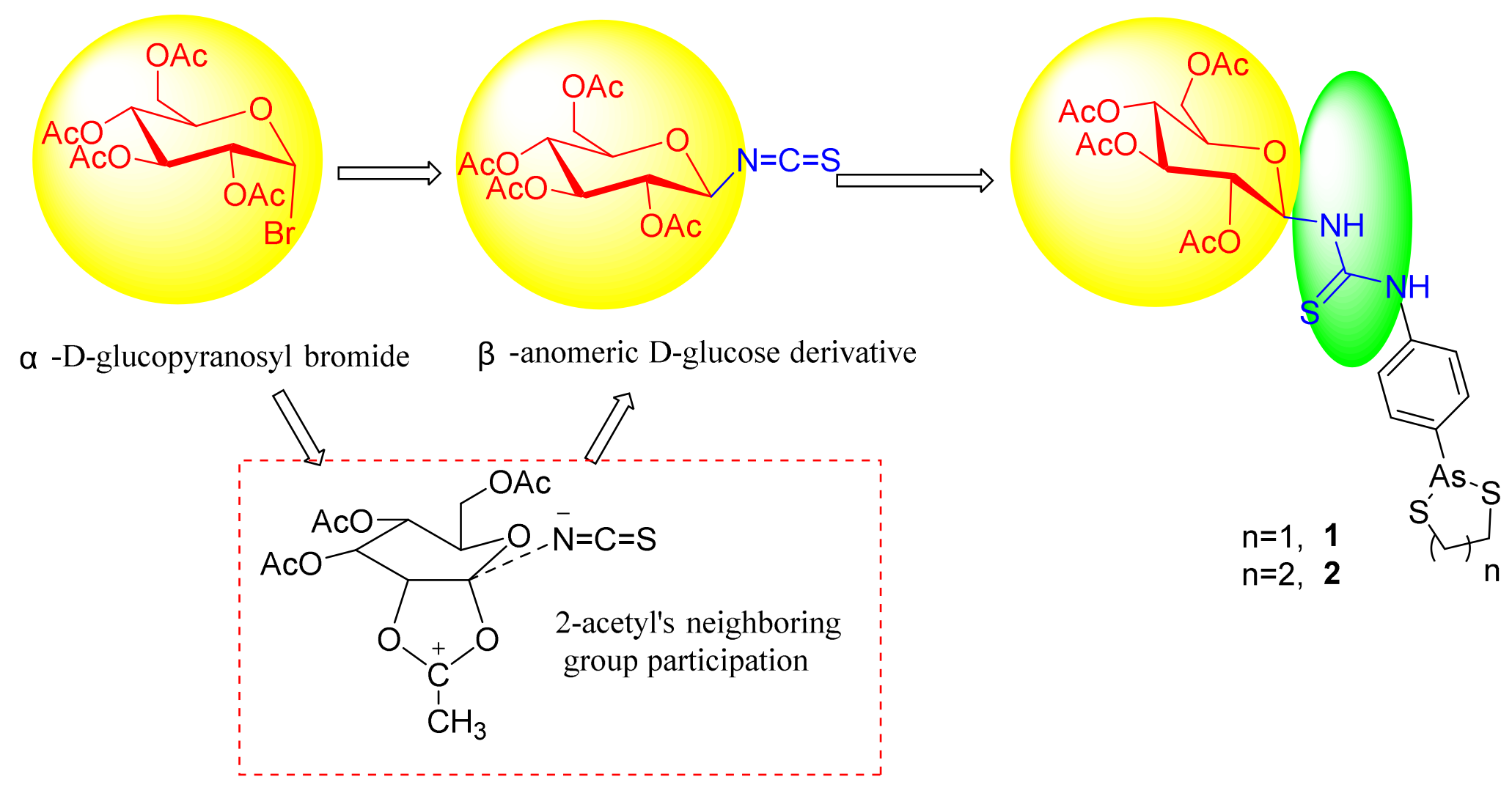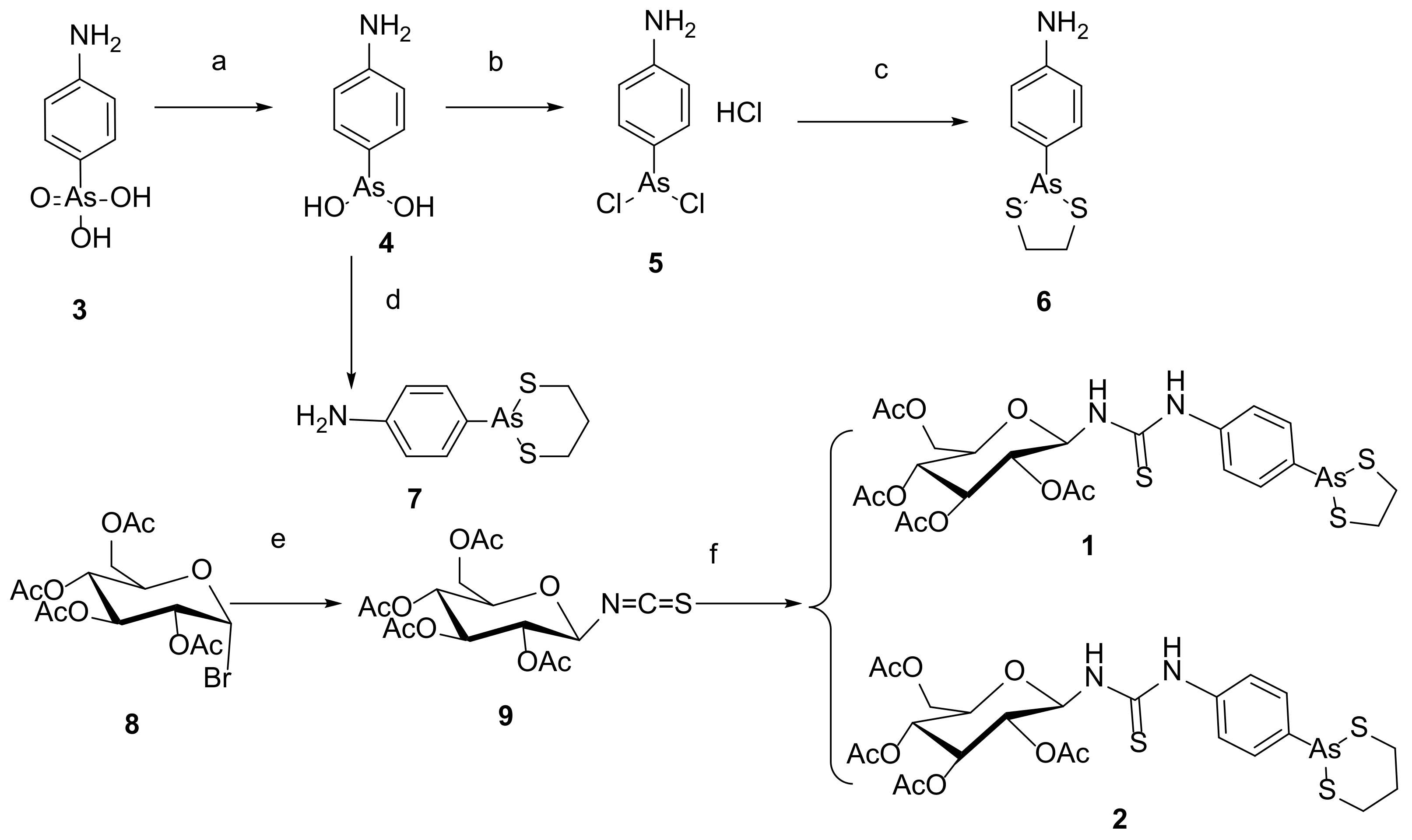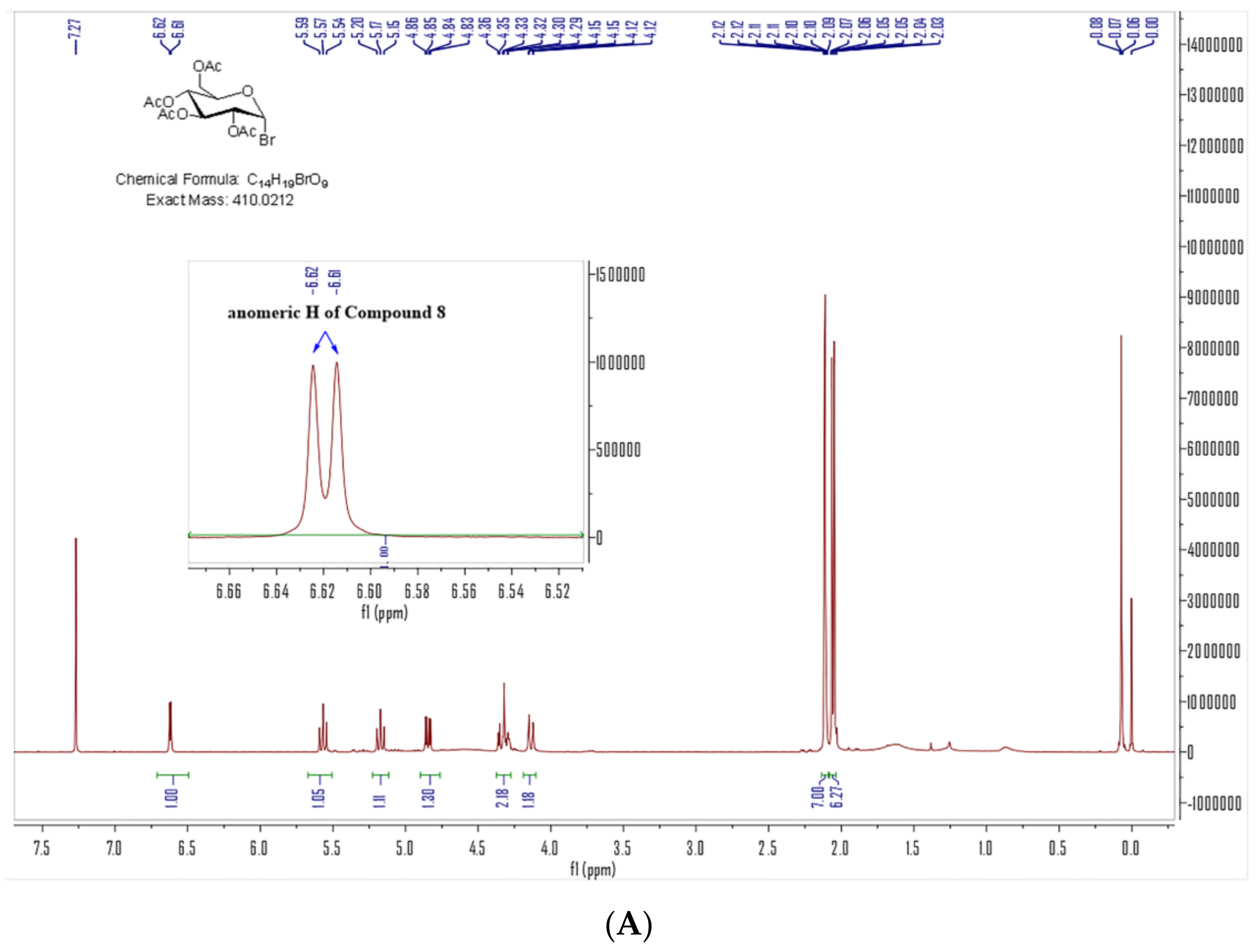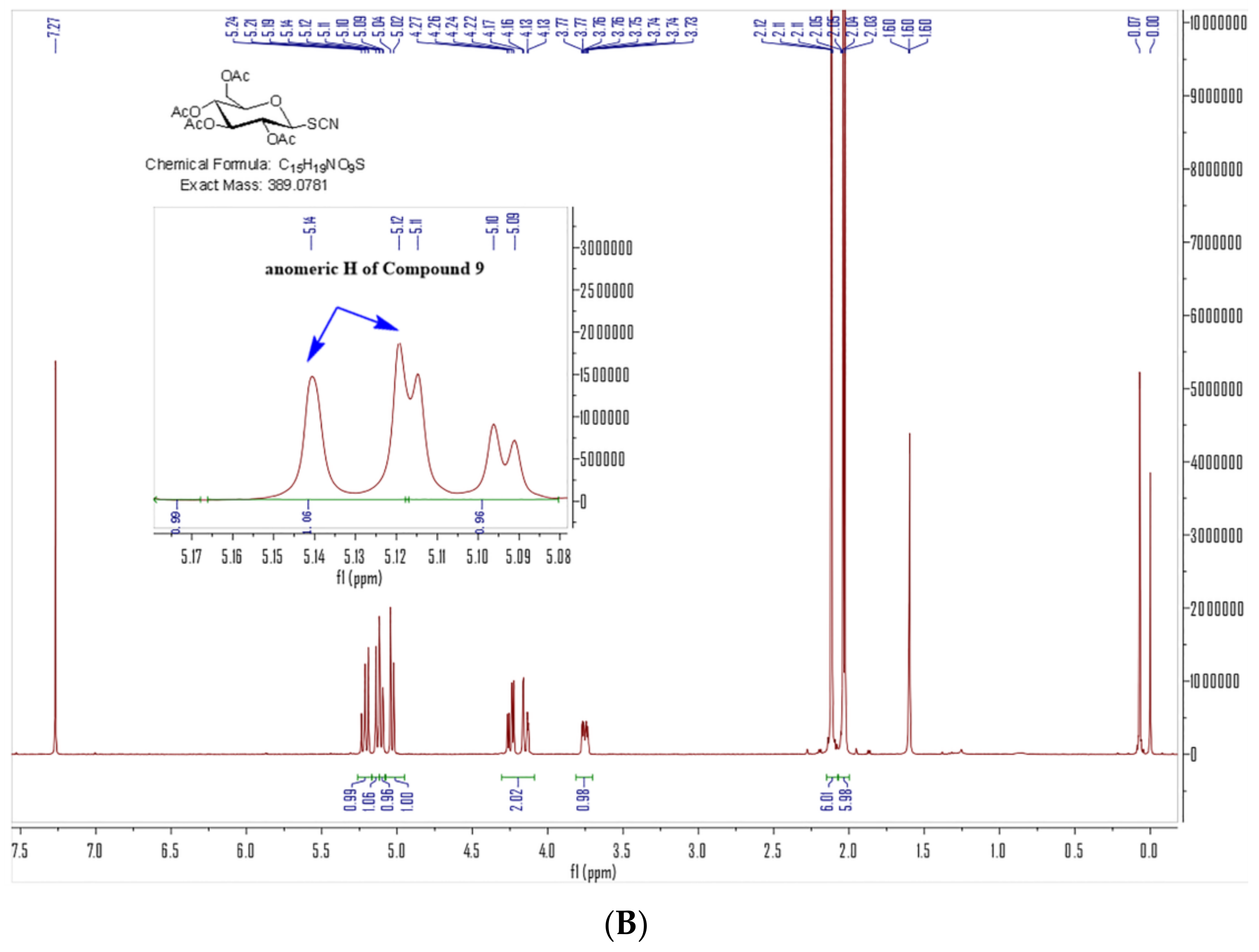Design and Synthesis of Thiourea-Conjugating Organic Arsenic D-Glucose with Anticancer Activities
Abstract
:1. Introduction
2. Results and Discussion
3. Materials and Methods
3.1. Synthesis of Compound 1, 2, 6, 7 and 9
3.1.1. 1-(4-(1,3,2-Dithiarsolan-2-yl) aniline)-2-N-(2,3,4,6-tetra-O-acetyl-β-d-glucopyranose-1-yl)-thiourea (1)
3.1.2. 1-(4-(1,3,2-Dithiarsinan-2-yl) aniline)-2-N-(2,3,4,6-tetra-O-acetyl-β-d-glucopyranose-1-yl)-thiourea (2)
3.1.3. 4-(1,3,2-Dithiarsolan-2-yl) aniline (6) [24,26]
3.1.4. 4-(1,3,2-Dithiarsinan-2-yl) aniline 7 [18]
3.1.5. 2,3,4,6-Tetra-O-acetyl-β-d-glucopyranosyl isothiocyanate (9) [30]
3.2. Cell Lines and Cell Culture [25]
3.3. MTT Assay [25]
4. Conclusions
Supplementary Materials
Author Contributions
Funding
Institutional Review Board Statement
Informed Consent Statement
Data Availability Statement
Acknowledgments
Conflicts of Interest
References
- Waxman, S.; Anderson, K.C. History of the Development of Arsenic Derivatives in Cancer Therapy. Oncologist 2001, 6, 3–10. [Google Scholar] [CrossRef] [PubMed]
- Swindell, E.P.; Hankins, P.L.; Chen, H.; Miodragović, Đ.U.; O’Halloran, T.V. Anticancer activity of small-molecule and nanoparticulate arsenic (III) complexes. Inorg. Chem. 2013, 52, 12292–12304. [Google Scholar] [CrossRef] [PubMed]
- Dilda, P.J.; Hogg, P.J. Arsenical-based cancer drugs. Cancer Treat. Rev. 2007, 33, 542–564. [Google Scholar] [CrossRef]
- Zhang, X.-W.; Yan, X.-J.; Zhou, Z.-R.; Yang, F.-F.; Wu, Z.-Y.; Sun, H.-B.; Liang, W.-X.; Song, A.-X.; Lallemand-Breitenbach, V.; Jeanne, M. Arsenic Trioxide Controls the Fate of the PML-RARα Oncoprotein by Directly Binding PML. Science 2010, 328, 240–243. [Google Scholar] [CrossRef] [PubMed]
- Emadi, A.; Gore, S.D. Arsenic trioxide—An old drug rediscovered. Blood Rev. 2010, 24, 191–199. [Google Scholar] [CrossRef] [PubMed]
- Zhu, J.; Lallemand-Breitenbach, V. Pathways of retinoic acid- or arsenic trioxide-induced PML/RARalpha catabolism, role of oncogene degradation in disease remission. Oncogene 2001, 20, 7257–7265. [Google Scholar] [CrossRef] [PubMed]
- Evens, A.M.; Tallman, M.S.; Gartenhaus, R.B. The potential of arsenic trioxide in the treatment of malignant disease: Past, present, and future. Leuk. Res. 2004, 28, 891–900. [Google Scholar] [CrossRef] [PubMed]
- Jiang, Y.; Shen, X.; Zhi, F.; Wen, Z.; Gao, Y.; Xu, J.; Yang, B.; Bai, Y. An overview of arsenic trioxide-involved combined treatment algorithms for leukemia: Basic concepts and clinical implications. Cell Death Discov. 2023, 9, 266. [Google Scholar] [CrossRef] [PubMed]
- Chen, S.; Wu, J.-L.; Liang, Y.; Tang, Y.-G.; Song, H.-X.; Wu, L.-L.; Xing, Y.-F.; Yan, N.; Li, Y.-T.; Wang, Z.-Y.; et al. Arsenic Trioxide Rescues Structural p53 Mutations through a Cryptic Allosteric Site. Cancer Cell. 2021, 9, 225–239. [Google Scholar] [CrossRef]
- Khairul, I.; Wang, Q.Q.; Jiang, Y.H.; Wang, C.; Naranmandura, H. Metabolism, toxicity and anticancer activities of arsenic compounds. Oncotarget 2017, 8, 23905–23926. [Google Scholar] [CrossRef]
- Zhang, H.-N.; Yang, L.; Ling, J.-Y.; Czajkowsky, D.M.; Wang, J.-F.; Zhang, X.-W.; Zhou, Y.-M.; Ge, F.; Yang, M.-K.; Xiong, Q. Systematic identification of arsenic-binding proteins reveals that hexokinase-2 is inhibited by arsenic. Proc. Natl. Acad. Sci. USA 2015, 112, 15084–15089. [Google Scholar] [CrossRef] [PubMed]
- Zhang, X.; Yang, F.; Shim, J.-Y.; Kirk, K.L.; Anderson, D.E.; Chen, X. Identification of arsenic-binding proteins in human breast cancer cells. Cancer Lett. 2007, 255, 95–106. [Google Scholar] [CrossRef] [PubMed]
- Hikita, E.; Arai, M.; Tanaka, S.; Onda, K.; Utsumi, H.; Yuan, B.; Toyoda, H.; Hirano, T. Effects of inorganic and organic arsenic compounds on growth and apoptosis of human T-lymphoblastoid leukemia cells. Anticancer Res. 2011, 31, 4169–4178. [Google Scholar] [PubMed]
- Wimmer, N.; Robinson, J.; Gopisetty-Venkata, A.N.; Roberts-Thomson, S.J.; Monteith, G.R.; Toth, I. Novel Glyco-lipid-arsenicals (III) with Anti-proliferative Effects on MCF-7 Human Breast Cancer Cells. Med. Chem. 2006, 2, 79–87. [Google Scholar] [CrossRef] [PubMed]
- Fan, X.-Y.; Chen, X.-Y.; Liu, Y.-J.; Zhong, H.-M.; Jiang, F.-L.; Liu, Y. Oxidative stress-mediated intrinsic apoptosis in human promyelocytic leukemia HL-60 cells induced by organic arsenicals. Sci. Rep. 2016, 6, 29865. [Google Scholar] [CrossRef] [PubMed]
- Zhang, L.; Tong, Y.; Zhang, X.; Pan, M.; Chen, S. Arsenic sulfide inhibits cell migration and invasion of gastric cancer in vitro and in vivo. Drug Des. Dev. Ther. 2015, 9, 5851–5862. [Google Scholar] [CrossRef] [PubMed]
- Ding, W.; Tong, Y.; Zhang, X.; Pan, M.; Chen, S. Study of Arsenic Sulfide in Solid Tumor Cells Reveals Regulation of Nuclear Factors of Activated T-cells by PML and p53. Sci. Rep. 2016, 6, 19793. [Google Scholar] [CrossRef] [PubMed]
- Fu, B.; Wang, X.; Li, Y.; Hu, J.; Lu, D.; Li, W.; Zheng, K.; Qin, C. Carbohydrate-conjugated 4-(1,3,2-dithiarsolan-2-yl) aniline as a cytotoxic agent against colorectal cancer. RSC Adv. 2018, 8, 40760. [Google Scholar] [CrossRef]
- Lee, J.S.; Adler, L.; Karathia, H.; Carmel, N.; Rabinovich, S.; Auslander, N.; Keshet, R.; Stettner, N.; Silberman, A.; Agemy, L.; et al. Urea Cycle Dysregulation Generates Clinically Relevant Genomic and Biochemical Signatures. Cell 2018, 174, 1559–1570. [Google Scholar] [CrossRef]
- Sarkar, K.; Dastidar, P. Rational Approach Towards Designing Metallogels From a Urea-Functionalized Pyridyl Dicarboxylate: Anti-inflammatory, Anticancer, and Drug Delivery. Chem. Asian J. 2019, 14, 194–204. [Google Scholar] [CrossRef]
- Kirishnamaline, G.; Magdaline, J.D.; Chithambarathanu, T.; Aruldhas, D.; Anuf, A.R. Theoretical investigation of structure, anticancer activity and molecular docking of thiourea derivatives. J. Mol. Struct. 2021, 1225, 129118. [Google Scholar] [CrossRef]
- Wael Abdelgayed, A.A.; Amira Atef, G.; Asmaa, K.M. N-Naphthoyl Thiourea Derivatives: An Efficient Ultrasonic-Assisted Synthesis, Reaction, and In Vitro Anticancer Evaluations. ACS Omega 2022, 7, 6210–6222. [Google Scholar] [CrossRef] [PubMed]
- Avvaru, S.P.; Noolvi, M.N.; More, U.A.; Chakraborty, S.; Dash, A.; Aminabhavi, T.M.; Narayan, K.P.; Sutariya, V. Synthesis and Anticancer Activity of Thiadiazole Containing Thiourea, Benzothiazole and Imidazo[2,1-b][1,3,4]thiadiazole Scaffolds. Med. Chem. 2021, 17, 750–765. [Google Scholar] [CrossRef] [PubMed]
- Fu, B.; Lv, L.; Xia, C.; Zheng, K.; Zhu, L.; Li, W.; Yan, Y.; Qin, C. Effects of Carbohydrates on the Toxicity of p-Aminophenyl Arsenoxide against S. cerevisiae. J. Med. Chem. Toxicol. 2017, 2, 28–33. [Google Scholar]
- Fu, B.; Li, Y.; Peng, S.; Wang, X.; Hu, J.; Lv, L.; Xia, C.; Lu, D.; Qin, C. Synthesis and pharmacological characterization of glucopyranosyl-conjugated benzyl derivatives as novel selective cytotoxic agents against colon cancer. R. Soc. Open Sci. 2021, 8, 201642. [Google Scholar] [CrossRef] [PubMed]
- Nukada, T.; Berces, A.; Zgierski, M.Z.; Whitfield, D.M. Exploring the Mechanism of Neighboring Group Assisted Glycosylation Reactions. J. Am. Chem. Soc. 1998, 120, 13291–13295. [Google Scholar] [CrossRef]
- Liu, Y.; Duan, D.; Yao, J.; Zhang, B.; Peng, S.; Ma, H.; Song, Y.; Fang, J. Dithiaarsanes Induce Oxidative Stress-Mediated Apoptosis in HL-60 Cells by Selectively Targeting Thioredoxin Reductase. J. Med. Chem. 2014, 57, 5203–5211. [Google Scholar] [CrossRef]
- Song, Z.; Zhang, J.; Xu, Q.; Shi, D.; Yao, X.; Fang, J. Structural Modification of Aminophenylarsenoxides Generates Candidates for Leukemia Treatment via Thioredoxin Reductase Inhibition. J. Med. Chem. 2021, 64, 16132–16146. [Google Scholar] [CrossRef]
- Stevenson, K.J.; Hale, G.; Perham, R.N. Inhibition of pyruvate dehydrogenase multienzyme complex from Escherichia coli with mono- and bifunctional arsenoxides. Biochemistry 1978, 17, 2189–2192. [Google Scholar] [CrossRef]
- Camarasa, M.J.; Fernandez-Resa, P.; Garcia-López, M.T.; Heras, G.D.H.; Mendez-Castrillon, P.P.; Felix, A.S. A New Procedure for the Synthesis of Glycosyl Isothiocyanates. Synthesis 1984, 15, 509–510. [Google Scholar] [CrossRef]
- Bubb, W.A. NMR spectroscopy in the study of carbohydrates: Characterizing the structural complexity. Concepts Mag. Res. A 2003, 19, 1–19. [Google Scholar] [CrossRef]





| IC50 (μM) | ||||
|---|---|---|---|---|
| 1 | 2 | 6 | 7 | |
| 293T | 3.14 ± 0.06 | 1.38 ± 0.01 | 4.06 ± 0.07 | 1.22 ± 0.06 |
| Hela | 14.4 ± 0.23 | 11.05 ± 0.17 | 6.49 ± 0.40 | 4.52 ± 0.68 |
| HepG2 | 7.62 ± 0.10 | 2.81 ± 0.03 | 6.11 ± 0.14 | 3.10 ± 0.37 |
| HCT-116 | 1.77 ± 0.11 | 0.82 ± 0.06 | 1.86 ± 034 a | 1.82 ± 0.07 |
| Selectivity index b | 1.77 | 1.68 | 2.18 | 0.67 |
Disclaimer/Publisher’s Note: The statements, opinions and data contained in all publications are solely those of the individual author(s) and contributor(s) and not of MDPI and/or the editor(s). MDPI and/or the editor(s) disclaim responsibility for any injury to people or property resulting from any ideas, methods, instructions or products referred to in the content. |
© 2024 by the authors. Licensee MDPI, Basel, Switzerland. This article is an open access article distributed under the terms and conditions of the Creative Commons Attribution (CC BY) license (https://creativecommons.org/licenses/by/4.0/).
Share and Cite
Fu, B.; Liu, W.; Wang, Y.; Li, G.; Wang, Y.; Huang, X.; Shi, H.; Qin, C. Design and Synthesis of Thiourea-Conjugating Organic Arsenic D-Glucose with Anticancer Activities. Molecules 2024, 29, 2850. https://doi.org/10.3390/molecules29122850
Fu B, Liu W, Wang Y, Li G, Wang Y, Huang X, Shi H, Qin C. Design and Synthesis of Thiourea-Conjugating Organic Arsenic D-Glucose with Anticancer Activities. Molecules. 2024; 29(12):2850. https://doi.org/10.3390/molecules29122850
Chicago/Turabian StyleFu, Boqiao, Wenxuan Liu, Yufeng Wang, Guorui Li, Yingsha Wang, Xinyuan Huang, Hongan Shi, and Caiqin Qin. 2024. "Design and Synthesis of Thiourea-Conjugating Organic Arsenic D-Glucose with Anticancer Activities" Molecules 29, no. 12: 2850. https://doi.org/10.3390/molecules29122850








